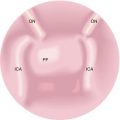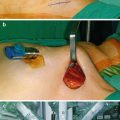John C. Watkinson and David M. Scott-Coombes (eds.)Tips and Tricks in Endocrine Surgery201410.1007/978-1-4471-2146-6_17
© Springer-Verlag London 2014
17. Anaplastic Thyroid Cancer
(1)
Department of Oncology, Queen Elizabeth Hospital Cancer Centre, Edgbaston, Birmingham, West Midlands, B15 2TH, UK
Abstract
Anaplastic, or undifferentiated, thyroid cancer is one of the most aggressive solid tumors with an extremely poor prognosis. It is believed that around 50 % of anaplastic thyroid cancers arise from a prior or coexistent differentiated thyroid carcinoma. The loss of the tumor suppressor gene p53 is an important step in this process.
Definition
Anaplastic, or undifferentiated, thyroid cancer is one of the most aggressive solid tumors with an extremely poor prognosis. It is believed that around 50 % of anaplastic thyroid cancers arise from a prior or coexistent differentiated thyroid carcinoma. The loss of the tumor suppressor gene p53 is an important step in this process.
Incidence
Anaplastic thyroid carcinoma is rare and its incidence is declining (currently 2 per million per year in the USA). It accounts for only 1.6 % of thyroid cancers but is responsible for up to half of all thyroid cancer deaths. It typically presents in the sixth or seventh decade of life and is more common in females.
Presentation
Rapidly enlarging neck mass (80 %)
Dysphagia (40 %)
Hoarse voice (40 %)
Stridor (25 %)
Lymph node mass (50 %)
Systemic symptoms: anorexia, weight loss
Symptoms of metastatic disease: SOB, bony pain, headaches
Investigations
Blood tests: Routine biochemistry, bone profile, full blood count, thyroid function, and thyroid autoantibodies.
Histology: US-guided FNA (accurate in 90 %) or core biopsy. Surgical biopsy may rarely be needed when there is diagnostic uncertainty. It is essential to differentiate anaplastic thyroid carcinoma from thyroid lymphoma or poorly differentiated medullary thyroid cancer as these have a much better prognosis.
Imaging
Staging CT scan of head, neck, chest, and abdomen will give information on local and distant staging. Most commonly metastasizes to the lung.
Bone scan: Bone metastases are usually lytic.
MRI scan may rarely be needed to assess local infiltration of the neck, particularly if surgery is planned.
Radioiodine scanning is not helpful.
Staging (International Union Against Cancer TNM Staging)
All anaplastic thyroid cancers are considered to be stage IV regardless of size and lymph node status. It should be considered as a systemic disease even if apparently localized.
T4a: Intrathyroidal and surgically resectable.
T4b: Extrathyroidal and not surgically resectable.
IVA: T4a, any N M0.
IVB: T4b, any N M0.
IVC: Any T, any N M1.
Histology
Macroscopically: Large unencapsulated invasive cancer with areas of necrosis and hemorrhage.
Microscopically: 3 variants – squamoid, spindle cell, and giant cell.
Stay updated, free articles. Join our Telegram channel

Full access? Get Clinical Tree





